

| Solar eclipse of August 3, 2073 | |
|---|---|
| Type of eclipse | |
| Nature | Total |
| Gamma | −0.8763 |
| Magnitude | 1.0294 |
| Maximum eclipse | |
| Duration | 149 s (2 min 29 s) |
| Coordinates | 43°12′S 89°24′W / 43.2°S 89.4°W / -43.2; -89.4 |
| Max. width of band | 206 km (128 mi) |
| Times (UTC) | |
| Greatest eclipse | 17:15:23 |
| References | |
| Saros | 127 (61 of 82) |
| Catalog # (SE5000) | 9672 |
A total solar eclipse will occur at the Moon's ascending node of orbit on Thursday, August 3, 2073, with a magnitude of 1.0294. A solar eclipse occurs when the Moon passes between Earth and the Sun, thereby totally or partly obscuring the image of the Sun for a viewer on Earth. A total solar eclipse occurs when the Moon's apparent diameter is larger than the Sun's, blocking all direct sunlight, turning day into darkness. Totality occurs in a narrow path across Earth's surface, with the partial solar eclipse visible over a surrounding region thousands of kilometres wide.
This eclipse is a member of a semester series. An eclipse in a semester series of solar eclipses repeats approximately every 177 days and 4 hours (a semester) at alternating nodes of the Moon's orbit.[1]
The partial solar eclipses on June 1, 2076 and November 26, 2076 occur in the next lunar year eclipse set.
| Solar eclipse series sets from 2073 to 2076 | ||||||
|---|---|---|---|---|---|---|
| Descending node | Ascending node | |||||
| Saros | Map | Gamma | Saros | Map | Gamma | |
| 122 | February 7, 2073 Partial |
1.1651 | 127 | August 3, 2073 Total |
−0.8763 | |
| 132 | January 27, 2074 Annular |
0.4251 | 137 | July 24, 2074 Annular |
−0.1242 | |
| 142 | January 16, 2075 Total |
−0.2799 | 147 | July 13, 2075 Annular |
0.6583 | |
| 152 | January 6, 2076 Total |
−0.9373 | 157 | July 1, 2076 Partial |
1.4005 | |
This eclipse is a part of Saros series 127, repeating every 18 years, 11 days, and containing 82 events. The series started with a partial solar eclipse on October 10, 991 AD. It contains total eclipses from May 14, 1352 through August 15, 2091. There are no annular or hybrid eclipses in this set. The series ends at member 82 as a partial eclipse on March 21, 2452. Its eclipses are tabulated in three columns; every third eclipse in the same column is one exeligmos apart, so they all cast shadows over approximately the same parts of the Earth.
The longest duration of totality was produced by member 31 at 5 minutes, 40 seconds on August 30, 1532. All eclipses in this series occur at the Moon’s ascending node of orbit.[2]
| Series members 46–68 occur between 1801 and 2200: | ||
|---|---|---|
| 46 | 47 | 48 |
 February 21, 1803 |
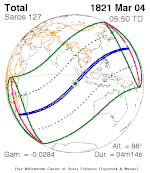 March 4, 1821 |
 March 15, 1839 |
| 49 | 50 | 51 |
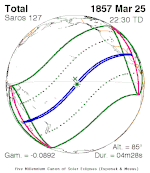 March 25, 1857 |
 April 6, 1875 |
 April 16, 1893 |
| 52 | 53 | 54 |
 April 28, 1911 |
 May 9, 1929 |
 May 20, 1947 |
| 55 | 56 | 57 |
 May 30, 1965 |
 June 11, 1983 |
 June 21, 2001 |
| 58 | 59 | 60 |
 July 2, 2019 |
 July 13, 2037 |
 July 24, 2055 |
| 61 | 62 | 63 |
 August 3, 2073 |
 August 15, 2091 |
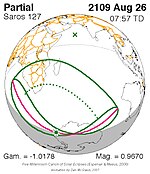 August 26, 2109 |
| 64 | 65 | 66 |
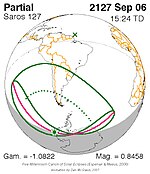 September 6, 2127 |
 September 16, 2145 |
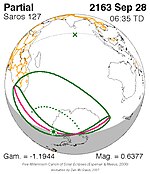 September 28, 2163 |
| 67 | 68 | |
 October 8, 2181 |
 October 19, 2199 | |
The metonic series repeats eclipses every 19 years (6939.69 days), lasting about 5 cycles. Eclipses occur in nearly the same calendar date. In addition, the octon subseries repeats 1/5 of that or every 3.8 years (1387.94 days). All eclipses in this table occur at the Moon's ascending node.
| 23 eclipse events between August 3, 2054 and October 16, 2145 | ||||
|---|---|---|---|---|
| August 3–4 | May 22–24 | March 10–11 | December 27–29 | October 14–16 |
| 117 | 119 | 121 | 123 | 125 |
 August 3, 2054 |
 May 22, 2058 |
 March 11, 2062 |
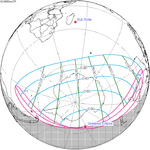 December 27, 2065 |
 October 15, 2069 |
| 127 | 129 | 131 | 133 | 135 |
 August 3, 2073 |
 May 22, 2077 |
 March 10, 2081 |
 December 27, 2084 |
 October 14, 2088 |
| 137 | 139 | 141 | 143 | 145 |
 August 3, 2092 |
 May 22, 2096 |
 March 10, 2100 |
 December 29, 2103 |
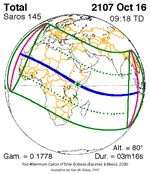 October 16, 2107 |
| 147 | 149 | 151 | 153 | 155 |
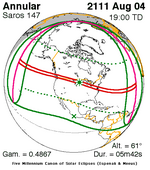 August 4, 2111 |
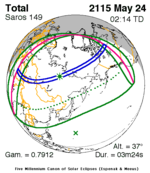 May 24, 2115 |
 March 11, 2119 |
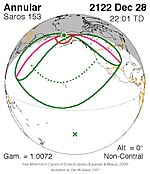 December 28, 2122 |
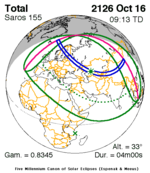 October 16, 2126 |
| 157 | 159 | 161 | 163 | 165 |
 August 4, 2130 |
 May 23, 2134 |
 October 16, 2145 | ||
This solar eclipse–related article is a stub. You can help Wikipedia by expanding it. |